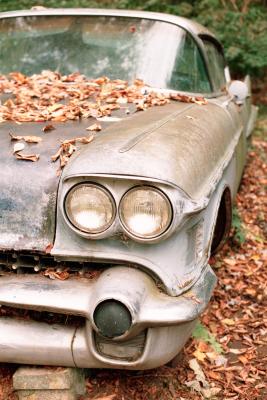
Though rust generally doesn't affect a car's driveability, it does affect its appearance, value and potential for restoration. Location, severity and other factors must be included when considering a rusty project car – surface rust, while certainly not desirable, is not as detrimental as corrosion, which is virtually impossible to reverse and expensive to fix. Although each individual must decide if a car is worth restoring based on his own experience, budget and abilities, knowing the extent of the rust damage goes a long way in making the call.
Get under the car with a flashlight and inspect the vehicle's undercarriage. Examine the floor pans – the main surface of the undercarriage – as well as the axle beams and the frame beams, or the structural rails enclosing the undercarriage. Check for any rust, noting where the rust appears and how it looks. Throughout the inspection, classify rust as surface rust or corrosive rust. Surface rust is generally orange- or light brown-hued and has only a slightly rough texture. This type of rust has not yet affected the structural integrity of the car. Corrosive rust, typically dark brown or deep ruddy red, features highly textured bumps, pits or flaking and does affect structural integrity.
Note any rust-related differences in the undercarriage. For instance, if one floor pan exhibits signs of rust and the other is pristine, this indicates recent body work, which may in turn indicate an accident or restoration procedures. Ask the current owner about the car's history – accidents may devalue the car but previous restoration efforts can give you a leg up.
Examine the wheel wells, muffler and exhaust pipes for either type of rust. Make note of the severity and type of the rust, which you'll refer to later when you decide whether or not to take the project on.
Check all of the body panels and bumpers for surface or corrosive rust. Corrosive rust on the body may occur under the paint, so pay attention to texture as well as color. Feel for any bubbled, flaking or pitted sections of the body. Search for rust near any scratches, dents or other areas where the paint or finish may have worn off.
Open the hood and check the shock or strut towers, which anchor the front suspension near the front windshield, for rust. Rusty towers will need replacement, which adds additional expense and labor to the restoration process.
Evaluate the severity of the rust, based on what type of rust it is. Surface rust is a cosmetic form of rust that can typically be reversed at home or with an inexpensive visit to the body shop. Corrosive rust spots that have caused bubbling of metal surfaces, rotting, flaking or flat-out holes require replacement of the affected area. While surface rust, a rusty quarter panel or rusty floor pan might not be enough to ward you off from restoration, rusted axle or frame beams can affect the car's overall structural integrity.
Consider your budget, experience and time frame. If you have the right combination of financial resources, supplies and experience to remedy areas of the vehicle affected by corrosive rust, the car may be worth restoring. Take other factors into account to evaluate the car as a whole. If the engine is in running condition with little need of repair and the car's interior cosmetics are intact, these factors may offset the costs of rust-related restoration.